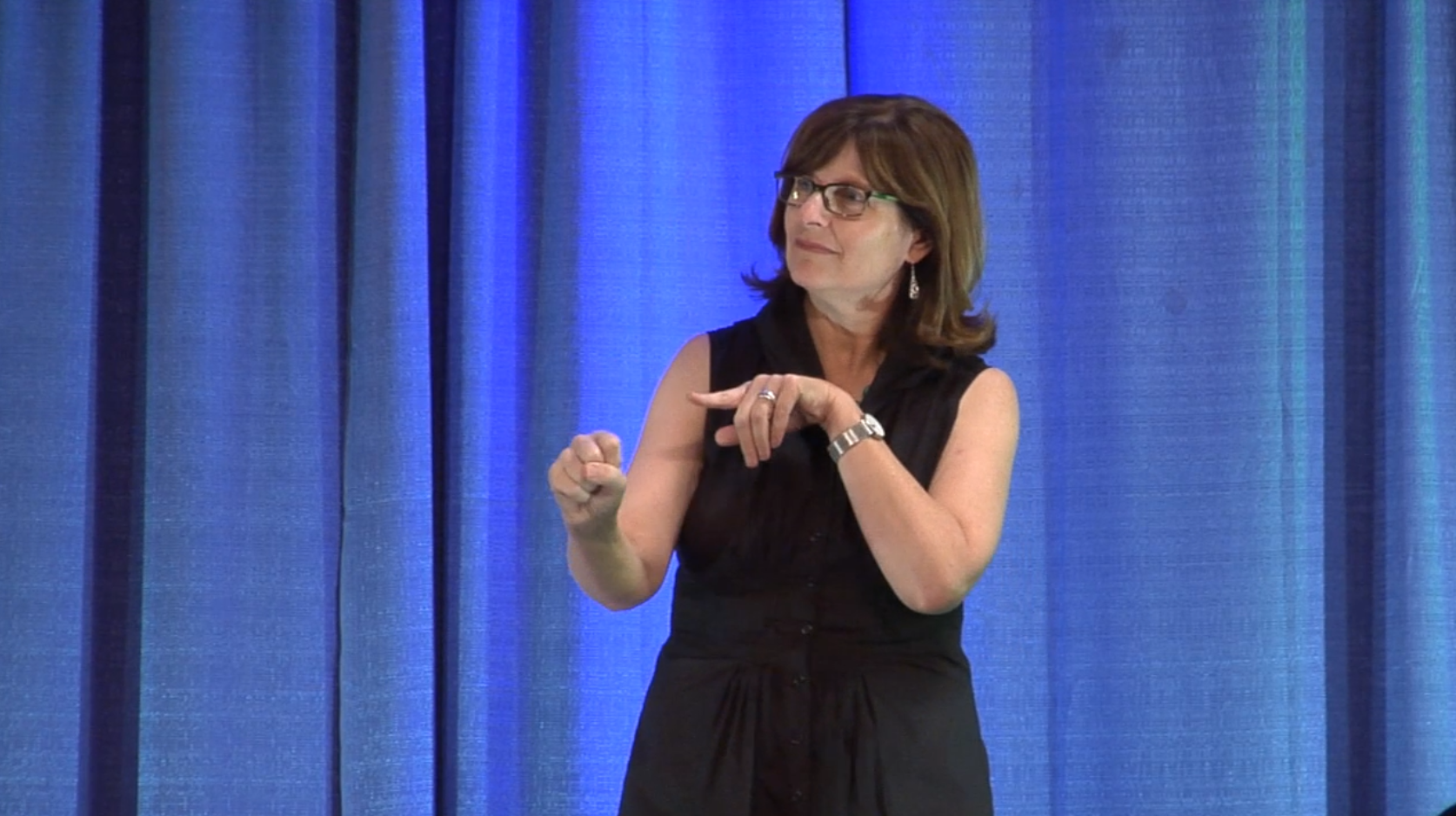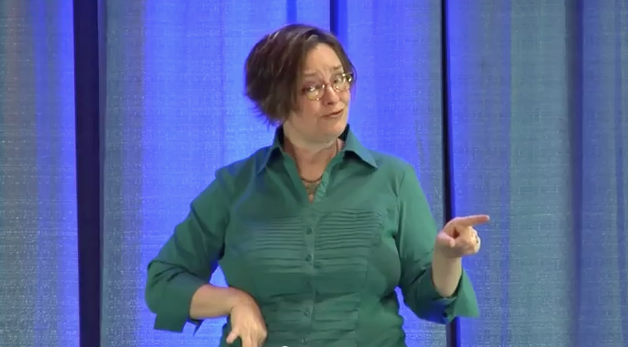
Kelly Decker examines common ways sign language interpreters frame the task of interpreting and peels back some of the implications and impact on the field and the larger communities served.
Sign language interpreters are taught that meaning is conveyed through accurate word choice. Do we give the same considerations to word choice when we label and describe interpreting itself? How do our words and actions frame our work?
As a professional sign language interpreter, I would like to address some of the language used when conversing with colleagues, training new interpreters, and depicting the profession to the mainstream media. The frames we use, as a profession, have the power to devalue the work we do, and by extension, the communities we serve. Continued reinforcement of these frames impacts public perception of sign language interpreting.
It takes years of intentional practice, reflection, and dedication to develop competence as a sign language interpreter. Platforms such as Street Leverage allow us to continually highlight and examine the ways we have yet to grow. MJ Bienvenu’s Bilingualism: Are Sign Language Interpreters Bilingual and Carol Padden’s Do Sign Language Interpreter Accents Compromise Comprehension? illustrate two fundamental problems we face in the field.
While we have begun to address the language we use to talk about our work, there is more work to do. I have selected four examples which demonstrate various ways interpreters contribute to current understandings of our work. There are many other examples that could be analyzed. I encourage you to contribute to this conversation online and with your colleagues to further examine how our use of language can contribute to a misperception of our profession and the disenfranchisement of the Deaf community. These types of conversations lead to greater awareness, which can be a catalyst for change.
The Labels We Use: “Terp”
It is not clear to me where this abbreviation came from. A cursory search on the internet found that it is cited as slang for “interpreter” and paired with the word ‘deaf’. We work with marginalized communities who are continuously disenfranchised regardless of the abundance of evidence and research regarding language, intelligence, and Deaf Gain [1]. We deflate our profession and the work we do for the sake of a few saved keystrokes.
This word “terp” (and I call it a word since it has become commonplace nomenclature and somewhat of a phenomenon within our field [i.e. TERPexpo],) is used primarily in written English when interpreters communicate with and refer to each other, and when interpreting agencies make requests for “terps”. The use of the term “Terp” does not stop within sign language interpreting circles. Since it has become somewhat the norm internally, it has spilled out into the larger community as the preferred label for what many interpreters want to be called. I feel this does a disservice to the field. I am an interpreter.
Misleading Terminology
“Hands-up”
As I understand it, in most instances, this phrase refers to actual interpreting. I come across it when dialoguing with ASL/English interpreting students. This term is used in practicum to indicate a requirement that is different from observation hours – the need for “hands-up” hours.
When sign language interpreters in the field and educators in interpreter education programs use this term to talk about the work we do, it implies that interpreters only interpret in one direction, into American Sign Language. It implies that Deaf people have nothing to say nor contribute. In reality, our work is working between – at least – two languages. This misguided idea is further bolstered by how our national organization frames the act of interpreting. The interpreter certification exam tests interpreting capabilities and decision-making. Yet ASL vlogs, created by RID, refer to the performance portion of the interpreting exam using a gloss that gives the literal impression that the exam is a “signing test”[2].
As explained above, “hands-up” addresses only half of the work we do. Or does it? When colleagues say “I prefer to work into ASL, it’s easier” or “I don’t do any ASL to spoken English work,” is it because interpreters, too, believe that interpreting is only done in one direction?
Additionally, the term “hands-up” perpetuates the erroneous notion that sign language interpreters, most of whom are second language learners of ASL, prefer to work into ASL because they are “comfortable”, “have more experience working into ASL,” or “feel they are clear”. Substantial evidence is to the contrary [3].
Interpreting, and more broadly, signed languages, have little to do with the hands. While sign language is expressed in a visual modality, the hands are but one element of that mode. Language is rich and complex. It conveys thoughts, emotions, and abstract ideas and it results in human connections. Language is influenced by and interwoven with culture. It is impacted by generational, intersectional and regional influences. Reducing an entire language to its modality is a prime example of how the dominant language and culture exerts power over and diminishes a linguistic and cultural minority.
“Voicing”
This term “voicing” has become commonplace within our field as a descriptor for the spoken language work we do as interpreters. It is a descriptor that oversimplifies the nature of the work, as if it requires no cognitive decision-making by the interpreter, nor cultural brokering between the two languages, and that the interpreter functions simply as a sign-by-sign voice over. In Jessica Bentley-Sassaman’s article, Taking Ownership: Defining Our Work As Sign Language Interpreters, she states “voicing” does not appropriately state what we do, what does is naming what we are actually doing when interpreting.
As the profession continues to use the term “voicing”, I believe that we perpetuate a medical perspective on deafness. It bolsters the idea, that when deaf people use sign language they need to be fixed somehow, given a voice, and that’s what interpreters are doing.
This portrayal of the work reinforces a view held by the majority culture that the language used by the Deaf community is somehow deficient. This misconception is propagated by the Alexander Graham Bell Association, whose position was made public [4] after the televised accomplishments of Nyle DiMarco, that desirable language development and outcomes for deaf children are only possible when focusing on listening and speaking, both of which are deeply rooted in the deficit-based medical model of what it means to be deaf.
As sign language interpreters, I believe we ought to unpack the implications and impacts of how we frame our work.
Perceptions of Professional Interpreters: Shake It Off [Interpreter Version] [5]
This video was so popular on social media after its release in December 2014, that the video’s participants were a part of the entertainment during RID’s 2015 national conference in New Orleans, LA. I have cited this piece not based on its participants but as an example of how we portray who we are, what our work entails, and how we approach the task of interpreting.
From what I gather, this video was made as a parody, a day-in-the-life of a sign language interpreter. All joking aside, what I cannot shake off while watching this video without audio input, is that it clearly represents misconceptions about the work we do:
(1) we only work into sign language, as the tired arms, hands and fingers portray;
(2) we only do this work for the money, as the interpreter runs off screen following the dollar bills;
(3) we self-medicate, as the abundance of pills clearly shows; and
(4) we can brush off the significance of the task of interpreting, as the title of the song conveys.
This day-in-the-life video makes no mention of the substantial cognitive work we do, which is the foundation of the product we produce. The sole focus is the self-aggrandizement of the interpreter. We must consider how this can contribute to the mainstream media’s abundance of misleading and demeaning pieces about sign language interpreters while #DeafTalent continues to go unnoticed.
Holding Ourselves Accountable
These examples are both subtle and not so subtle. As these flawed representations proliferate, we, as practitioners, as educators, and as a professional organization, become complacent and immune to the deleterious effect they have on our profession. We may dismiss it, saying, “This is the way we’ve always talked about the work,” “This how my interpreter training program said it,” or “I never really thought about it.”
We need to think about it. We need to talk about it. We need to question and remind each other when we use language that trivializes our work.
Mastery of interpreting is no easy feat. It is a labor of love, a demanding cognitive endeavor, and a dedication to craft. Above all, we are collectively accountable to representing our work with the utmost respect for the Deaf community.
How will you model talking about the work we do?
Questions for Consideration:
- The ways in which we, as a profession, talk about the work we do is anchored upon our understanding of what interpreting means. Are the ways we portray the work, the profession, and the communities we serve accurate?
- How do you think the ways that we talk about the work impact the profession?
- Do you have examples of times when dialoguing with colleagues where how they were talking about the work just did not sit right?
- With those examples in mind, how can you further explore what it is that did not sit right?
References:
[1] Bauman, H-Dirksen and Murray, Joseph. Editors. Deaf Gain Raising the Stakes for Human Diversity. University of Minnesota Press. October 2014.
[2] Registry of Interpreters for the Deaf, Inc. RID Announces Moratorium on Credentialing You Tube https://www.youtube.com/watch?v=Y6PM4a1tR7E Posted 9 Aug 2015.
[3] Nicodemus, Brenda and Emmorey, Karen. Directionality in ASL-English interpreting Accuracy and articulation quality in L1 and L2. Interpreting. Vol 17:2. 2015. p. 145-166.
[4] Sugar, Meredith. Dispelling myths about deafness. Online: http://www.agbell.org/inthe-news/response-nyle-dimarco/ Posted 1 April 2016
[5] Ott, Stephanie. Shake It Off [Interpreter Version] You Tube https://www.youtube.com/ watch?v=DS2UdoXS3xA Posted 13 Dec 2014.











